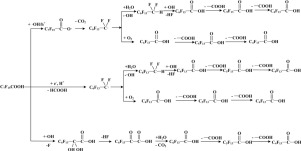Molecular Catalysis ( IF 4.6 ) Pub Date : 2017-09-01 , DOI: 10.1016/j.mcat.2017.08.014 Li Wang , Lei Sun , Zebin Yu , Yanping Hou , Zhenbo Peng , Fei Yang , Ying Chen , Jun Huang

|
The Fe3O4@SiO2-BiOBr (FSB) magnetic composite was prepared and introduced into the dielectric barrier discharge (DBD) system as a heterogeneous Fenton-like photocatalyst for synergistic degradation of perfluorooctanoic acid (PFOA). The FSB was characterized by X-ray diffraction, UV–vis diffuse reflectance spectra, energy dispersive X-ray spectroscopy and scanning electron microscope. Characterization results demonstrated that BiOBr was successfully coated on Fe3O4@SiO2, forming FSB, and it exhibited good UV & visible response. The presence of FSB accelerated PFOA degradation: PFOA removal efficiency and total organic carbon removal from DBD-FSB system increased from 73.5% to 92.9% and 28.9% to 62.5%, respectively, within 60 min under reaction conditions of 20 mg L−1 PFOA, initial pH 4.28, 100 mg L−1 FSB and 22 kV peak voltage, as compared with DBD system. Accordingly, defluorination efficiency of PFOA and energy efficiency increased from 21% to 32.8% and 46.39 mg kW−1h−1 to 72.47 mg kW−1h−1, respectively. The synergetic mechanism was attributed to the combination of active species such as OH, H2O2, O3, directly generated from the DBD plasma and a great amount of
OH generated from Fenton-like reaction initiated by FSB photocatalyst under light irradiation emitted during discharge. The
OH and photogenerated holes played essential roles in the mineralization process. Based on the identified intermediates, possible degradation pathways of PFOA in DBD-FSB system were proposed, and PFOA degradation mainly occurred via the pathway of perfluoroalkyl radical pathway.
中文翻译:

Fe 3 O 4 @SiO 2 -BiOBr磁性光催化剂在介质阻挡放电等离子体系统中全氟辛酸的协同分解性能及机理
制备了Fe 3 O 4 @SiO 2 -BiOBr(FSB)磁性复合材料,并将其作为非均相类Fenton型光催化剂引入介电势垒放电(DBD)系统中,以协同降解全氟辛酸(PFOA)。FSB的特征在于X射线衍射,紫外可见漫反射光谱,能量色散X射线光谱和扫描电子显微镜。表征结果表明BiOBr成功地涂覆在Fe 3 O 4 @SiO 2上,形成FSB,并表现出良好的紫外线和可见光响应。FSB的存在加速了PFOA的降解:在20 mg L -1 PFOA的反应条件下,在60分钟内,从DBD-FSB系统中去除PFOA的效率和总有机碳分别从73.5%增至92.9%和28.9%增至62.5%。与DBD系统相比,初始pH为4.28、100 mg L -1 FSB和22 kV峰值电压。因此,PFOA的脱氟效率和能量效率分别从21%增加到32.8%和46.39mg kW -1 h -1到72.47mg kW -1 h -1。协同作用机制归因于活性物质如OH,H 2 O的结合如图2所示,由DBD等离子体直接产生的O 3和
由FSB光催化剂在放电期间发出的光照射下引发的Fenton样反应产生的大量OH。该
OH和光生空穴在矿化过程中发挥了重要作用。基于所鉴定的中间体,提出了在DBD-FSB系统中PFOA的可能降解途径,PFOA的降解主要通过全氟烷基自由基途径发生。



























 京公网安备 11010802027423号
京公网安备 11010802027423号